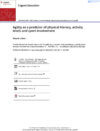Objective
Given the increasing importance being placed on levels of youths’ physical literacy (PL), physical activity (PA) and sport involvement (SI), it would seem plausible to investigate a common physical activity outcome (PAO) that would go to predict success throughout these domains. The impact of various demographic variables, on physical performance, is of interest. This study hypothesised that levels of agility predict the success in a number of PAOs.
Design
A variance (ANOVA), with repeated measures, was conducted to determine if the physical performance responses differed significantly from each other for selected PAO.
Setting
Two hundred and thirty-four (234) school-aged students (11–17+ years) had data (quantitative) collected across six PAOs, which were selected based on their inherent connections to domains.
Method
Correlation matrices and Structural Equation Modelling (SEM) were further used to examine and diagrammatically represent the significance (p < 0.05—p < 0.000) of associations and relationships (r) between levels of agility and each PAO.
Results
Strength of the direct effect identifies that higher levels of agility, being male (r = .208**, p < 0.001) and a light—moderate BMI (r = .223**, p < 0.05), significantly moderates the pathways between all PAOs. The SEM indicated that the approach fits the data set very well (p < .05, Chi Square/DF<3, and other fit values in the .95–1.00 region).
Conclusion
Findings suggest that more attention should be directed towards promoting the inherent benefits of improving school-aged students’ agility levels, with an aim to developing reciprocating positive impacts on domains.



Responses